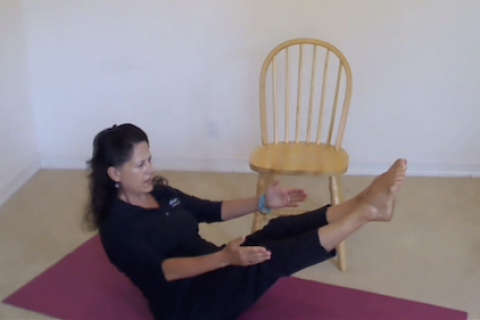The 30-minute sessions, held midday twice a week, guided participants to tune into their breath and led them through a series of easy, gentle movements.
Two years on, the program is still going strong. Yoga therapist Julie Rowland leads live classes on Tuesdays and Thursdays that require no previous yoga experience and no yoga mat. Open to all, the classes are medically approved regardless of health conditions and can be done while seated in a chair (even at your desk).
“As long as you’re breathing, you can practice yoga,” Rowland says.
What is yoga therapy?
Rowland typically begins by inviting students to focus on their breath, then links this conscious breathing with simple movements, such as stretching the arms overhead or bending at the waist.
The practice is more breath-oriented than fitness-oriented, Rowland says.
“The yoga that we see in the gym or at the Y is like a smorgasbord: you get a little bit of this and a little bit of that — a little bit of different postures, a little bit of breathing, a little bit of meditation at the end, if you’re lucky,” she says.
UCLA Health’s yoga therapy sessions are focused on cultivating relaxation in the mind and body, Rowland says.
“Yoga therapy is more like a finely crafted meal specific for you. It’s prescriptive. That’s what differentiates it from a regular yoga practice.”
Elizabeth Ko, MD, medical director of UCLA Health Integrative Medicine Collaborative, describes yoga therapy sessions as “a welcomed mid-day break to move, breathe and connect.”
“Integrative medicine modalities, including yoga, are a refuge for promoting personal morale, self-efficacy skills and psychologic well-being,” says Dr. Ko, who is also trained as a yoga instructor.
“To be able to teach these ancient practices in a Western medical model is one of the big goals of yoga therapy,” Rowland adds.
The role of the breath
Rowland’s yoga therapy classes focus on the breath because it’s “a direct line to overriding the autonomic nervous system,” she says.

“Your breath, your mood and your pulse rate are like three points of a triangle, and you can’t change one without changing the other two,” Rowland says. “So if I said lower your pulse rate, you couldn’t do it. If I said come on, get happy right now, you couldn’t do it.
"But if I said let’s take a few deep breaths, you can do that. And there have been many, many studies about the power of conscious breathing.”
Students of yoga therapy say they’ve been able to use the breathing practices to calm themselves in stressful situations, such as before medical appointments and exams.
“People say, ‘I’m happier. I sleep better. Though my pain hasn’t gone away, I’ve reduced the pain. I used to have headaches,’” Rowland says. “They come back and report, ‘You know, it worked. I feel better.’”
Open to all
UCLA Health’s yoga therapy sessions are available to anyone, whether or not they live in Southern California or are patients of UCLA Health. Anyone with a connected device can click the Zoom link and attend the live class. A library of previous sessions is also available online.
“Eyes open or closed; in a chair or on the floor; inside or outside; give it a try,” Rowland says. “If you’re reading this, then you’re already interested.”
Learn more about Integrative Medicine at UCLA Health.
Related:
Music, healing touch, oils and meditation brought to the bedside



